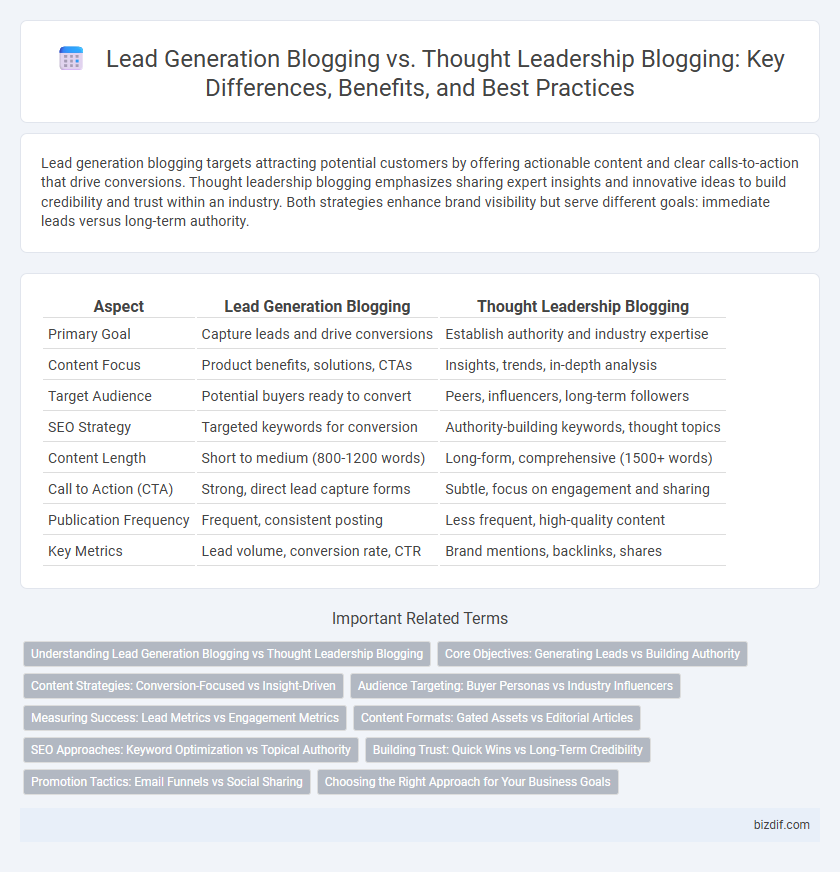Lead generation blogging targets attracting potential customers by offering actionable content and clear calls-to-action that drive conversions. Thought leadership blogging emphasizes sharing expert insights and innovative ideas to build credibility and trust within an industry. Both strategies enhance brand visibility but serve different goals: immediate leads versus long-term authority.
Table of Comparison
| Aspect | Lead Generation Blogging | Thought Leadership Blogging |
|---|---|---|
| Primary Goal | Capture leads and drive conversions | Establish authority and industry expertise |
| Content Focus | Product benefits, solutions, CTAs | Insights, trends, in-depth analysis |
| Target Audience | Potential buyers ready to convert | Peers, influencers, long-term followers |
| SEO Strategy | Targeted keywords for conversion | Authority-building keywords, thought topics |
| Content Length | Short to medium (800-1200 words) | Long-form, comprehensive (1500+ words) |
| Call to Action (CTA) | Strong, direct lead capture forms | Subtle, focus on engagement and sharing |
| Publication Frequency | Frequent, consistent posting | Less frequent, high-quality content |
| Key Metrics | Lead volume, conversion rate, CTR | Brand mentions, backlinks, shares |
Understanding Lead Generation Blogging vs Thought Leadership Blogging
Lead generation blogging targets converting visitors into potential customers by integrating clear calls-to-action, landing pages, and promotional offers within content designed to address specific customer pain points and solutions. Thought leadership blogging builds authority and trust by sharing expert insights, industry trends, and innovative ideas that position the blogger or brand as a credible influencer in their niche. Understanding the distinction involves recognizing that lead generation aims for measurable sales funnel progression, while thought leadership prioritizes brand reputation and long-term relationship building.
Core Objectives: Generating Leads vs Building Authority
Lead generation blogging focuses on creating targeted content that drives conversions by capturing contact information through calls-to-action and landing pages. Thought leadership blogging aims to build authority by sharing expert insights, industry trends, and innovative ideas that establish credibility and trust among the audience. While lead generation targets measurable business outcomes like sales funnel growth, thought leadership emphasizes long-term brand influence and recognition within the industry.
Content Strategies: Conversion-Focused vs Insight-Driven
Lead generation blogging targets conversion-focused content strategies by creating clear calls-to-action, landing pages, and gated content designed to capture leads. Thought leadership blogging emphasizes insight-driven content strategies, delivering in-depth analysis, expert opinions, and innovative ideas that establish authority and credibility. Balancing both approaches can optimize engagement while driving measurable business growth.
Audience Targeting: Buyer Personas vs Industry Influencers
Lead Generation Blogging targets buyer personas by creating content that addresses specific pain points, purchasing behavior, and decision-making criteria to drive conversions and sales. Thought Leadership Blogging focuses on engaging industry influencers through insightful and forward-thinking content that establishes authority and fosters professional trust. Audience targeting in lead generation is more transactional, while thought leadership emphasizes relationship-building within the industry ecosystem.
Measuring Success: Lead Metrics vs Engagement Metrics
Lead Generation Blogging success is measured primarily through lead metrics such as conversion rates, click-through rates, and the number of qualified leads generated from blog content. Thought Leadership Blogging effectiveness is evaluated using engagement metrics like time on page, social shares, comments, and the growth of brand authority within the industry. Both approaches require distinct key performance indicators to accurately assess their impact on business goals.
Content Formats: Gated Assets vs Editorial Articles
Lead generation blogging leverages gated assets such as eBooks, whitepapers, and webinars designed to capture visitor information and convert readers into leads. Thought leadership blogging emphasizes editorial articles that provide in-depth insights, expert opinions, and industry trends to establish authority and build long-term trust with the audience. The choice between gated assets and editorial content depends on goals, with gated assets driving direct conversions and editorial articles fostering brand credibility and audience engagement.
SEO Approaches: Keyword Optimization vs Topical Authority
Lead generation blogging centers on keyword optimization, targeting high-intent search terms to drive conversions and capture potential customer data. Thought leadership blogging emphasizes building topical authority by creating comprehensive, in-depth content that establishes expertise and gains trust within a niche. SEO strategies for lead generation prioritize short-tail and commercial keywords, while thought leadership SEO relies on long-tail keywords and semantic relevance to improve search rankings and domain authority.
Building Trust: Quick Wins vs Long-Term Credibility
Lead generation blogging focuses on quick wins by creating targeted content that captures immediate interest and prompts direct action, such as email sign-ups or sales inquiries. Thought leadership blogging builds long-term credibility through insightful, authoritative articles that demonstrate expertise and foster sustained audience trust. Balancing both approaches enhances overall trust by combining instant engagement with lasting influence.
Promotion Tactics: Email Funnels vs Social Sharing
Lead generation blogging leverages targeted email funnels to nurture prospects with personalized content, driving conversions through strategic follow-ups and segmented lists. Thought leadership blogging emphasizes social sharing and community engagement, utilizing platforms like LinkedIn and Twitter to amplify authority and foster organic reach. Choosing between email funnels and social sharing depends on campaign goals, with lead generation favoring direct, measurable interaction and thought leadership prioritizing broad visibility and influence.
Choosing the Right Approach for Your Business Goals
Lead generation blogging centers on creating content that drives conversions by capturing potential clients' contact information through targeted calls-to-action and landing pages. Thought leadership blogging emphasizes establishing authority and trust by sharing insightful, industry-specific expertise that engages a professional audience. Selecting between these approaches depends on your business goals: prioritize lead generation for immediate customer acquisition and thought leadership for long-term brand credibility and influence.
Lead Generation Blogging vs Thought Leadership Blogging Infographic

 bizdif.com
bizdif.com